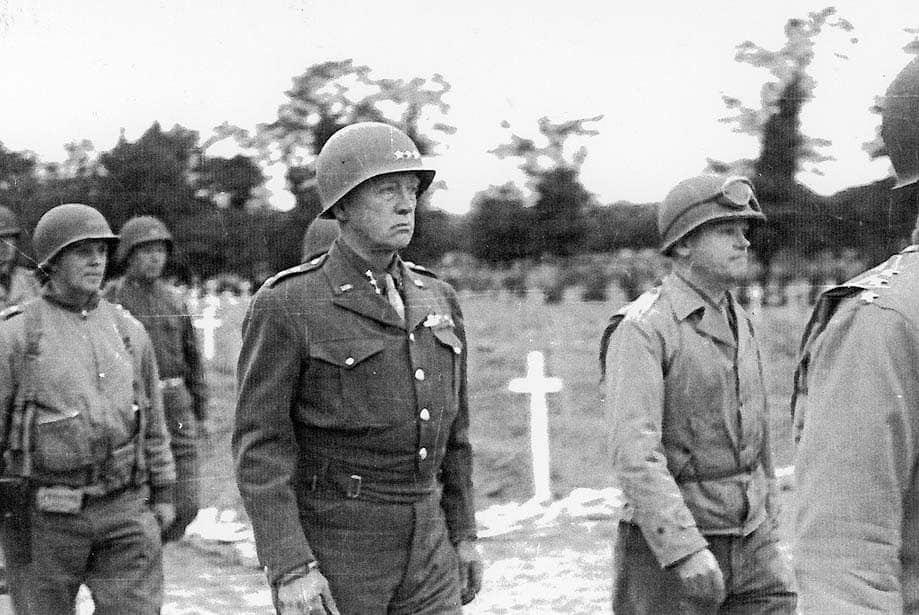
In early August 1943, Lieutenant General George S. Patton slapped two United States Army soldiers under his command during the Sicily Campaign of World War II. Patton’s hard-driving personality and lack of belief in the medical condition combat stress reaction, then known as “battle fatigue” or “shell shock”, led to the soldiers becoming the subject of his ire in incidents on 3 and 10 August, when Patton struck and berated them after discovering they were patients at evacuation hospitals away from the front lines without apparent physical injuries. From Wikipedia. For more details click on this link. Click on photo to enlarge.
By: Phil Kohn. Dedicated to the memory of his father, GM3 Walter Kohn, U.S. Navy Armed Guard, USNR, and all men and women who have answered the country’s call in time of need. Phil can be contacted at ww2remembered@yahoo.com.
The Battle of Vella Gulf is fought on the night of August 6, 1943: Four Japanese destroyers attempt to bring troops and supplies to New Georgia, Solomon Islands, and are attacked by six U.S. destroyers. Three Japanese destroyers are sunk and one is damaged. The U.S. vessels suffer no damage. On New Georgia itself, Munda airfield is captured by American troops, giving the U.S. control of the island. In Germany, the government orders a partial evacuation of Berlin to avoid another Hamburg situation of tremendous civilian casualties.
Failing to receive needed reinforcements and supplies (because of the Japanese defeat at the Battle of Vella Gulf) and because of the capture of Munda airfield, Maj. Gen. Minoru Sasaki on August 7 moves his headquarters from New Georgia to nearby Kolombangara Island, leaving only a token force of defenders behind on New Georgia.
Beginning on August 8, German troops deploy throughout Italy. Hitler’s plan: to occupy as much of Italy as possible, using it as a bastion to keep the war as far away from Germany as possible. The U.S. Army, as part of its plan for the defense of the eastern United States, bans the taking of photographs at beach resorts along the East Coast, or even the painting or sketching of beach scenes. Civilian violators could be subject to trial in a military court.
In Africa, the United States on August 9 signs a military assistance treaty with Ethiopia, which had been liberated from Italian control in 1941. In Pune, India, thousands march in protest to mark the one-year anniversary of the arrest of Mohandas Gandhi, who is incarcerated there for his leadership role in the anti-British “Quit India” movement. Hundreds are arrested.
On August 10, for the second time within a week, U.S. Army Lt. Gen. George S. Patton, visiting the wounded at an evacuation hospital in San Stefano, Sicily, loses his temper and slaps a soldier diagnosed with “battle fatigue,” accusing him of cowardice. Word of both incidents makes its way to war correspondents, who inform Gen. Eisenhower’s chief of staff. In addition, the second incident — in which Patton also threatens the soldier with his drawn pistol — is officially reported up the chain of command by the II Corps surgeon, Col. Richard Arnest. The story breaks in the U.S. when newspaper columnist Drew Pearson gets wind of the events and reports them on his radio program. Despite calls by some members of Congress and the media for Patton to be relieved of command, he instead receives a stern personal reprimand from Gen. Eisenhower, who strongly suggests that Patton apologize to all involved. Patton does so.
The Axis evacuation of Sicily begins on the night of August 11. German and Italian troops are transferred to the Italian mainland via 134 small craft shuttling across the 2.5-mile-wide Strait of Messina under cover of 500 anti-aircraft guns. On the Eastern Front, Hitler orders the creation of an “Eastern Wall,” a line of defense on the eastern edge of German-occupied territory in Latvia, Lithuania and Estonia.
On August 12, the RAF makes its heaviest attack so far on northern Italy, with more than 1,000 tons of bombs dropped on Milan in under 30 minutes. In Poland, the Polish Home Army (Armia Krajowa) resistance group ambushes a truck in Warsaw in mid-day and makes off with 106 million złoty (roughly U.S. $33 million) being transported by the Nazi occupation authorities. The Red Army takes Chuhuiv, Ukraine, about 24 miles southeast of Kharkiv.



